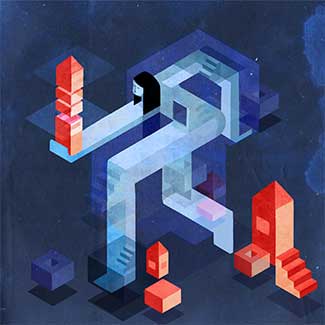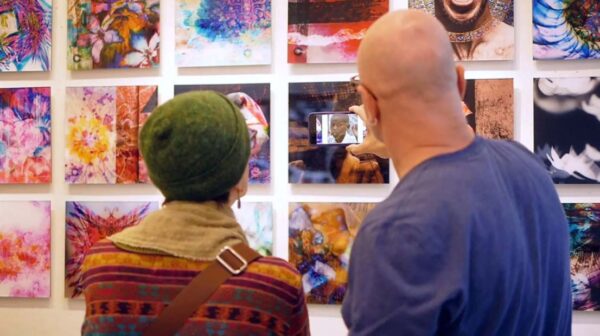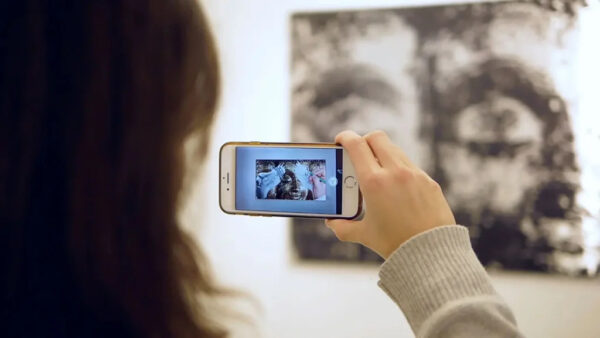Artist Interview: Christopher Jeauhn Bayne
I no longer have the borders of the canvas in my head, and I see the audience interacting with my work in a more complex and immersive way
Digitalization has become a big factor in our everyday life, changing not only our daily routine but also the way we create and perceive art. More and more artists are working with digital and analog media, seeking to find solutions to connect both worlds. Using augmented reality, Artivive provides artists with a simple tool to extend their work from a physical to a digital level. Breaking the rules and boundaries of the traditional media, Artivive gives artists infinite creative possibilities. As result, the artwork becomes alive in front of the viewers, telling them its own story and opening up a completely new level of content and perception.
After spending the last years working side by side with many artists providing them with the Artivive tool, we would like to feature their work on our blog. A new blog-post series with artist interviews will give voice to their opinions about AR and their experience with the Artivive tool.
This time we’ve met the South African Vienna-based artist Christopher Jeauhn Bayne. Fresh from his first big solo exhibition “WHAT ARE YOU LOOKING AT” presenting only artworks enhanced with AR, Christopher talked to us about his inspirations, artistic process, as well as the role of AR and Artivive in his work.
1. Can you tell us a little about your art and your background?
My formal introduction to art was through textile design, in Cape Town, South Africa. After arriving in Europe in 1993, I branched out into acrylic paint followed by mixed-media techniques a few years later. But as the creative learning processes continued, I found myself completing a Diploma in Web Design and Development, a Certificate in Transmedia Storytelling, and a Masters Degree in Creative Media Practice. These all fuelled my passion for art even more, and in 2015, I exchanged my brushes and canvasses for digital equivalents, entirely.
2. How did you come across Artivive why did you choose to include augmented reality into your practice?
I discovered Artivive in a promotional article in the Vangardist magazine a few years ago. Since I was already working digitally, it seemed like the obvious next step. I was blown away the first time it worked with my art! And it’s wonderful to see that same expression of surprise on the faces of the viewers. Thanks to Artivive, I finally had a storytelling tool, so now my artworks can truly speak for themselves. I can show more facets of the work, rather than only a static image.
3. What do you find most exciting about augmented reality?
The possibilities for social change, on an international scale. Augmented reality can be used for enhancing art, but with some lateral thinking, it can also be used in so many other ways, which could influence and inform the viewer. What may look benign out on the street, could contain an AR statement with serious social content. It could be anywhere.
The artist at the exhibition “WHAT ARE YOU LOOKING AT” © Artivive
4. What subject matters interest you? What are some of the stories behind your work?
Inspired by people, society, religion, history, and the natural world in general, my work consists of many layers of imagery, which fuse to form a composite whole. Fascinated by dualism and polarity in all aspects, I create art that blends beauty and horror, yin and yang, dark and light, pixels, and dpi, to create an experience, heightened by augmented reality, in which the viewer can move between fascination and consternation; very much in the same way that I experience life.
5. How has Artivive impacted the work you are producing?
The impact has been huge. I now found myself merging media and viewing video in an entirely new way. I no longer have the borders of the canvas in my head, and I see the audience interacting with my work in a more complex and immersive way. Artivive has changed absolutely everything.
“WHAT ARE YOU LOOKING AT” © Artivive
6. Can you describe your work process?
I use the Adobe Suite (mostly Photoshop, Illustrator, and After Effects) but I still work relatively traditionally, choosing my canvass size, substrate, and printing medium before I begin a new piece. The artworks are therefore created specifically for a particular substrate (e.g. aluminum, paper, glass, or wood) and printing medium (each medium proving its own visual effect). Technically, sometimes I start with a video component, creating the static artwork from there, and at others, I create the artwork statically and produce the AR later. I usually have an idea as to what I would like to express, but I allow the work a fair amount of flexibility to grow on its own as the creative process continues.
7. Which among the works you have created using Artivive is your favorite and why?
There are a good few, as after such a long time producing artwork, the range of work can be very different. Mmmm,… I suppose I would have to choose “Lilies” produced in summer, 2018. I started with a time-lapse video of lilies blooming, and extracted frames from the video, reworking them in photoshop with a watercolor action, and adding brush effects. The final result is a large work (128 x 72 cm) that appears abstract, very much handmade, in watercolors, but presented as a high-resolution photograph. But its beauty is not what it seems. After all, what is it? A photograph? A watercolor? A video? An AR art piece? And does it matter? It’s good art!
8. What memorable responses or interactions have you had or witnessed as a result of your work?
I recently had an exhibition of 42 AR works in Vienna, Austria. For me, the best part of the 5-day exhibition was watching the looks of surprise on the faces of people, especially when they walked in off the street, not even knowing it was an AR exhibition and were then swept off their feet by the experience. It was wonderful!
9. What do you plan to work on next?
I wish I could talk about all the irons I have in the fire, but unfortunately, many of them are top secret, at least for now. I do plan to have another AR exhibition in 2019 though!
Interested to enhance your artwork with augmented reality? Sign up for free to our augmented reality tool.


